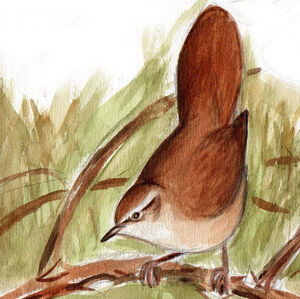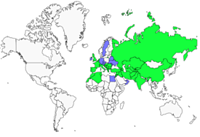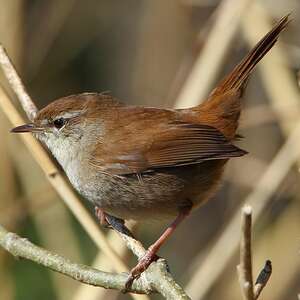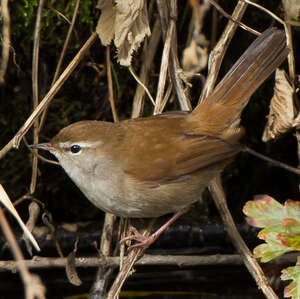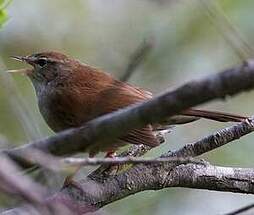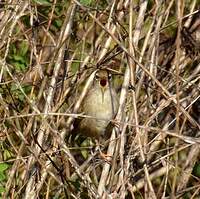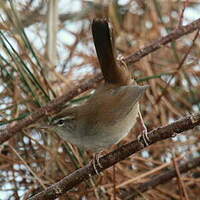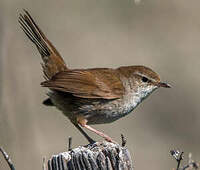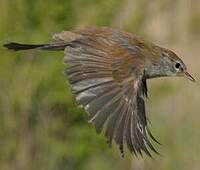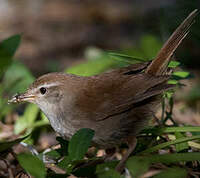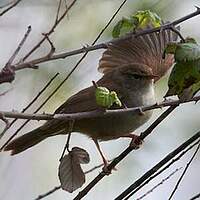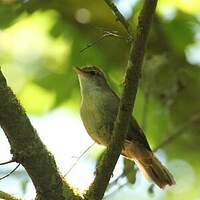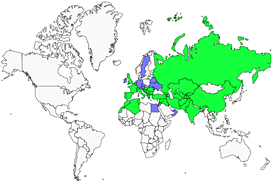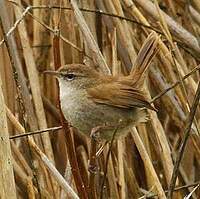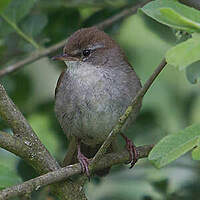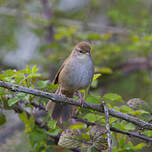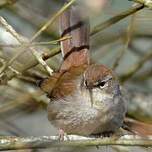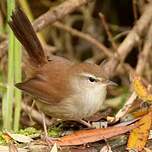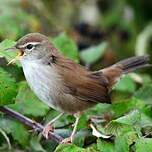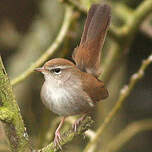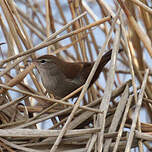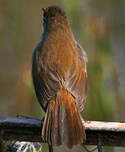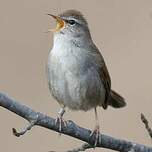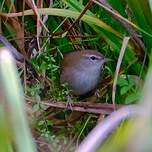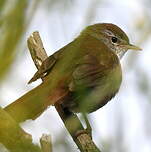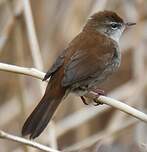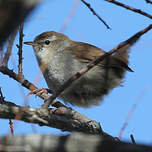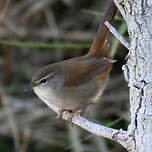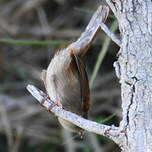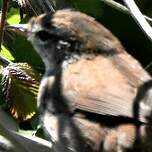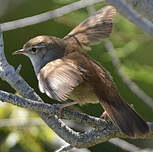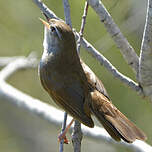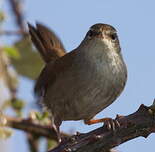Cetti's Warbler
Cettia cetti - Bouscarle de Cetti
Identification
Cetti's Warbler is a small bird with discreet plumage and behaviour. With its thin beak and its posture, it resembles a warbler. The upper parts are warm brown, clearly tinged with chestnut. The flight feathers and the tail feathers are dark brown. The primary projection is very short. Although it has only 10 tail feathers (the norm is 12), its tail is wide (family character) and slightly rounded at the tip, the feathers edged with chestnut.
The head has a pale eyebrow which sometimes widens at the back of the eye, becoming diffuse. A grey tinge covers the sides of the neck and head. The throat is white to cream. The dark eye is marked by a white eye arc that contrasts with its upper homologous, merged into the eyebrow. The thin and fairly short beak is black, with the base of the lower mandible paler, pink.
The lower parts are dark khaki, with the chest invaded by the same grey as the cheeks. The robust legs are yellowish, rosaceous or reddish.
The juvenile has a duller plumage.
It could be confused with the Common Grasshopper Warbler which can frequent the same reed beds, but the latter is colder brown, does not have the grey tint in the front of the body, has a stronger beak and shows very long undertail feathers.
Subspecific information 3 subspecies
- Cettia cetti cetti (w Europe to Greece and the Balkans, nw Africa)
- Cettia cetti orientalis (Turkey to Iran and Afghanistan)
- Cettia cetti albiventris (Kazakhstan and Turkmenistan to nw China and n Afghanistan)
Foreign names
- Bouscarle de Cetti,
- Cetia ruiseñor,
- rouxinol-bravo-ocidental,
- Seidensänger,
- berki poszáta,
- Cetti's Zanger,
- Usignolo di fiume,
- cettisångare,
- Cettisanger,
- cetia západná,
- cetie jižní,
- Cettisanger,
- silkkikerttunen,
- rossinyol bord comú,
- Blæsöngvari,
- wierzbówka (zwyczajna),
- cetija,
- svilnica,
- Соловьиная широкохвостка,
- ヨーロッパウグイス,
- 宽尾树莺,
- 寬尾樹鶯,
Voice song and cries
The song of the Cetti's Warbler is a short, explosive phrase, very loud, made of notes in quick succession, the first detached from the others. It can be translated with the following onomatopoeia TÍ tipitipitipi ti-pi-ti-pi. It has several calls, a plip like a sparrow, a low and dry pset, a uit like a wren, but more emphasized. A churr of a river warbler punctuates interactions between individuals. The alarm call is a rapid succession of tit or tet which can even go into a trill and is reminiscent of the equivalent call of the wren which by the way can frequent the same places.
Habitat
Cetti's Warbler is found at least in western Europe in densely vegetated wet areas with bushes such as willows, brambles, plum trees, etc. along rivers, pools, marshes, irrigated crops and on the margins of wet woodlands such as alder, poplar, riparian habitats. Phragmites marshes are especially sought. They are always close to water but the tree cover should not be too extensive. Further east, it is also found in more open wetlands with small copses along streams, including at high altitude.
Behaviour character trait
The presence of the Cetti's Warbler is most often detected by its song. Indeed, it lives hidden in the cover of vegetation and rarely shows itself in the open.
Its dull brown plumage does not make the task of the observer easier, even if they are patient! It is particularly difficult to observe, even though it is common in many areas. In shrubs or in reeds, it moves hopping from one stem to another or on the ground, agitated by nervous movements. It often raises its tail.This cettiid is mainly sedentary to the west of its range and can therefore be affected by severe cold winters to the point of disappearing abruptly from a territory, as was the case in northern France in January 1985.
Flight
Dietfeeding habits
Reproduction nesting
Cetti's Warbler is known for frequently practicing polygamy, particularly where it is common. Females normally make two successive nests.
The nest is built from vegetal elements (leaves, dry grass, fibers) and lined internally with feathers, fur and other soft elements such as the fluff of rushes. It is hung in the shrubby and/or herbaceous vegetation (rushes, nettles, etc.) up to a height of 2 meters, often held by a fork. The female lays 3-4 eggs, sometimes 5, of a plain light reddish brown. She alone is responsible for incubation for 16 to 17 days. Young remain in the nest for a bit less than 15 days and are dependent on adults for another fifteen days after they take flight.Geographic range
Cetti's Warbler occupies a variable width band that stretches from the Atlantic to central Asia and eastern Kazakhstan. To the west, it is mainly Mediterranean, occupying the coast of the Mediterranean, except for Libya and Egypt, but it also moves north on the Atlantic coast due to the oceanic climate. This is why it can be found everywhere in France, except for the extreme northeast, and occasionally in the south-east of the UK. It is sedentary there.
On the other hand, the populations of the extreme south of western Russia, Kazakhstan and inner Turkey are migratory and winter in the southern part of the nesting area, but also disjointly up to the Persian Gulf and the north of the Indian Ocean.
Threats - protection
Sources of information
- IOC World Bird List (v13.2), Gill, F and D Donsker (Eds). 2023.
- HBW Alive,
- Avibase, Lepage Denis
- xeno-canto, Sharing bird sounds from around the world,
Other sources of interest
 Specification sheet created on
21/07/2023 by Jean François
Specification sheet created on
21/07/2023 by Jean FrançoisTranslation by AI Oiseaux.net
published: 15-09-2018 - Updated: 17-09-2018
© 1996-2024 Oiseaux.net
- Accipitriformes
- Aegotheliformes
- Anseriformes
- Apodiformes
- Apterygiformes
- Bucerotiformes
- Caprimulgiformes
- Cariamiformes
- Casuariiformes
- Charadriiformes
- Ciconiiformes
- Coliiformes
- Columbiformes
- Coraciiformes
- Cuculiformes
- Eurypygiformes
- Falconiformes
- Galliformes
- Gaviiformes
- Gruiformes
- Leptosomiformes
- Mesitornithiformes
- Musophagiformes
- Nyctibiiformes
- Opisthocomiformes
- Otidiformes
- Passeriformes
- Pelecaniformes
- Phaethontiformes
- Phoenicopteriformes
- Piciformes
- Podargiformes
- Podicipediformes
- Procellariiformes
- Psittaciformes
- Pterocliformes
- Rheiformes
- Sphenisciformes
- Steatornithiformes
- Strigiformes
- Struthioniformes
- Suliformes
- Tinamiformes
- Trogoniformes

